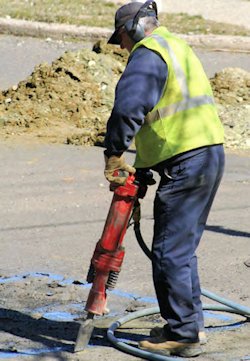Environmental and Ergonomic Hazards
Noise Hazards
Noise, or unwanted sound, is one of the most widespread occupational health problems. Exposure to high levels of noise causes hearing loss and may also cause other harmful health effects. The extent of damage primarily depends on the intensity of the noise and the duration of the exposure. Exposure to high levels of noise is cumulative and can cause permanent hearing loss. Neither surgery nor a hearing aid can help correct this type of hearing loss. Construction sites have many noisy operations and can be a significant source of noise exposure.

OSHA requires employers to monitor noise exposure levels in a way that accurately identifies employees exposed to noise at or above 85 decibels (dB) averaged over 8 working hours, or an 8-hour time-weighted average (TWA). Employers must provide hearing protectors to all workers exposed to 8-hour TWA noise levels at or above 85 dB. This requirement ensures that workers have access to protectors before they experience any hearing loss.
2-3 Foot Rule and Noise Indicator
When a sound level meter is not available, you should use the 2-3 foot rule: stand about an arm's length away from your coworker. If you have to raise your voice to be heard 2-3 feet away, you should assume the sound level is at or above 85 dBA.
A personal noise indicator is a warning device that indicates whether your immediate exposure is less than or greater than 85 dBA. It flashes green if the sound level is under 85 dBA and red when above 85 dBA.
Knowledge Check Choose the best answer for the question.
2-1. At what point is the employer required to provide hearing protection for workers?
You forgot to answer the question!
